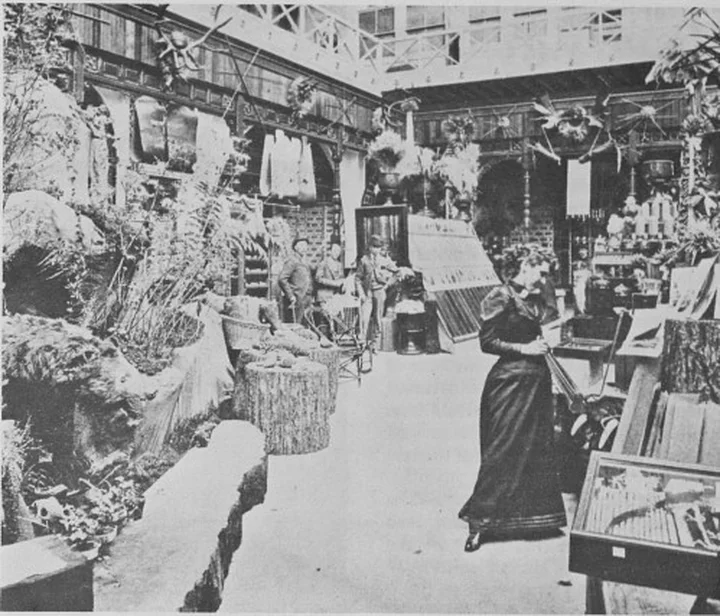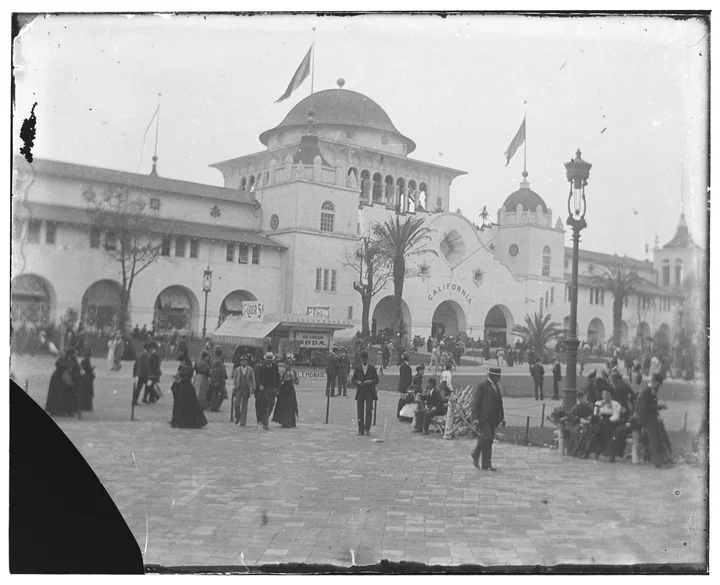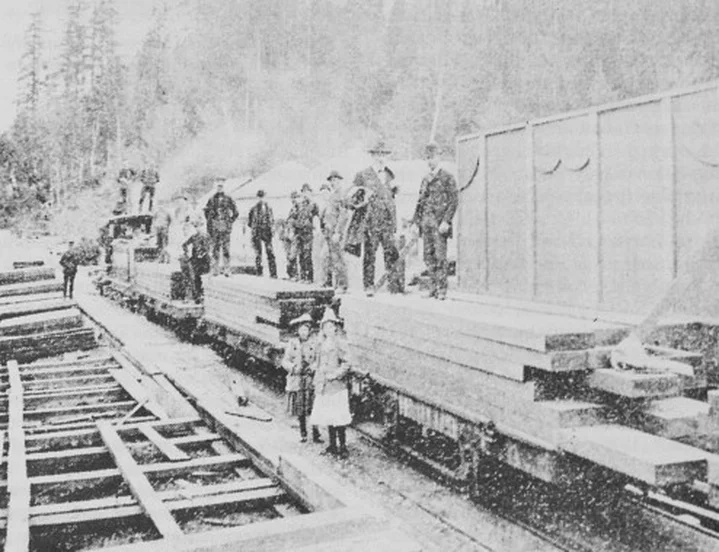This is the Humboldt County room at the 1893 World’s Columbian Exposition at Chicago. The woman in the foreground is Martha J. Herrick, manager of the Humboldt exhibit, and the man nearest the camera in the background is California Governor H.H. Markham. Photo via The Humboldt Historian.
Early in the year, 1893, my father saw posters and newspapers advertising the world’s fair in Chicago and, being 17 years old, he wanted more than anything to go see this exciting event. His folks did not want him to go but he had saved a few dollars he had earned, packed a few things and headed for the fair.
The first night away he started thinking about his folks and how badly they needed him to help with the farm work. He turned around and went back home. Here is one thing he missed: The beautiful California building and the Humboldt County exhibit at the World’s Columbian Exposition.
The exposition was opened May 1, 1893, and closed October 30, 1893. It was located at Jackson Park on the shore of Lake Michigan.
The plans for the California building were drawn by A. Page Brown of San Francisco. It was a Spanish mission-style building, rectangular in shape and three stories high. It measured 144 feet wide and 435 feet long. The building was of frame construction and the exterior was covered with what was called “staff,” a mixture of fiber and rough cement, having a light gray tint to imitate adobe. The roof was covered with red tile and the building had several towers with flag poles at the top displaying California and American flags.
The California Hall at the World’s Columbian Exhibition. Photo: Frank Day Robinson. Public domain. Via The Huntington Library/Calisphere.
With the exception of the Illinois building, the California structure was the largest building on the fairgrounds. The formal dedication of this building was held Monday, June 19, 1893, with addresses by California Governor, H,H. Markham, and other notables,
California sent a grand total of 156 train carloads and 37 partial carloads of display material by railroad to the fair at full tariff rates. But, after the close of the exposition, the railroad returned all display material free to original destinations. This advantage was not given individual displays.
On February 19, 1892, the Humboldt County Chamber of Commerce requested $7,500 to finance a county exhibit at the Columbian Exposition. There were other requests for financial assistance from the Board of Supervisors, from groups such as lumber manufacturers and the Board of Horticulturists. These were turned down.
The members of the Board of Supervisors were as follows: Walter Scott, First District, Ferndale; W.J. Swortzel, Second District, Fortuna; John A. Moore, Third District, Blue Lake; H.M. Mercer, Fourth District and Niel Hill, Fifth District, The Clerk of the Board was Oscar Stern. The Board decided to allow $5,000 for the Humboldt County display and donations from firms and individuals amounted to $500, making a grand total of $5,500.

Martha J, Herrick, manager of the Humboldt County exhibit at the 1893 fair in Chicago. Photo via the Humboldt Historian.
Frank A. Wick and John Dolbeer were delegates to the fair convention, held April 20, 1892, in San Francisco. They reported to the Board July 12, 1892, The fair delegates asked that Mrs. Martha Herrick be manager and represent Humboldt County at the Columbian Exposition. She had an extensive collection of local Indian artifacts which she exhibited at the exposition and was awarded a medal for the private exhibit. G.D. Herrick was her assistant at the fair and G.A. Woodcock was part-time assistant. So, with this help, she set up the Humboldt County display.
In the extreme northwest corner of the California building, Humboldt County filled a floor space of 52 by 26 feet, or an area of 1,352 square feet. The unique display had more of an outdoor air about it than any other in the building and was suggestive of the forest and mountain slope, with deer, bear, and other wild animals in the setting.
At the same time, the products of the county were well represented. The entire exhibit from Humboldt County was surrounded by an elaborate enclosure of polished redwood, built of fancy shingled panels up to a height of 4 feet, at distances of about ten feet apart, were light and neatly turned columns, which supported an oddly ornate arrangement of redwood, with the words, “Humboldt County Exhibit” appearing in fretwork and extending entirely across each end. Upon the inner frieze were hung aloft about twenty pairs of antlers, representing nearly every species of deer and elk, also Rocky Mountain sheep from the northern part of the state. Between the mounted antlers were Indian bows and arrows, spears, war clubs and saddles, all used with excellent decorative effect.
Entering from the north, the first feature that caught the eye to the right was a wedge-shaped structure about 8 feet high and 12 feet long, set on end. A broad band of redwood panels surrounded the base, while above was a row of photographic scenes showing the forests and lumber camps of Humboldt County. Above that was a line of handsome panels, comprising the lighter colored woods, such as white cedar, white oak and Douglas fir. And above these was still another row of photographs. Capping the top, or ridge, were a number of bottles of Humboldt County mineral water and three large redwood vases filled with bouquets of grains and grasses.
To the left, a terraced pyramid held on its lower steps crystal jars of fruits and vegetables, with inverted bottles of barley, oats, peas, beans, etc. A line of dainty cylinders of amber and ruby jellies were on the higher steps.
In the southwest corner. irregularly fortified behind short sections of logs from native forest trees. was an imitation “rockery” that attracted much attention. There was a mound of mimic rocks. set with patches of real moss and tufts of genuine ferns and native shrubbery. Beneath was a good sized cave and, at the mouth. stuffed specimens of Humboldt County’s fauna peered forth, the most prominent being a huge stuffed grizzly bear. Indian baskets, shells, wood specimens, photographs and other items were thrown lightly down upon the moss at the base of the rockery.
This solid piece of clear redwood, shown crated and standing on edge, was a contribution to the 1893 Chicago Fair by Isaac Minor. This picture was taken at the Glendale Mill near Arcata. The slab of redwood was 7 feet high, 18 feet long and 4 inches thick.
Elsewhere, within the enclosure, was a variety of displays, including a section of redwood tree, 16 feet in diameter; a splendid board of redwood burl, 8 by 4 feet; a cabinet of burl and laurel woods; an interesting cabinet of minerals; samples of leather and leather work; a miniature museum of curios and Indian relics; a glass case containing a garland of flowers formed of shells; vases, urns, plates, knives and forks made from native woods; elkhorn and whalebone chairs; specimens of large and small fish in alcohol; sun-dried specimens; vegetables of unusual size in jars of clear preservative solutions; grain in sheaf and seed; wool and other commodities.
The manager of the exhibit devoted much of her time to giving short talks or semi-lectures to visitors on different features displayed, especially those relating to the early Indian tribes, their habits and history. Together, with curios in general, and facts bearing upon the value of the forest of Humboldt County, newspapers and other descriptive literature were distributed.
After the exposition closed on October 30, 1893, the California Commission tried to give the California building to the Park Commission of Chicago for a museum, but the Park Commission declined the offer because the building was not permanent enough to house valuable displays. An agreement entered into between this commission and the executive offices of the World’s Columbian Exposition stipulated that California should be given free use of the tract allotted but that the building should be removed at the expense of the California Commission and the grounds restored to their original condition for park purposes. All this was to be completed by May 1, 1894.
Most of the salvage companies of that day wanted several thousand dollars to remove the building. Finally, a contractor offered to pay the Commission $560 for the building and this offer was accepted and the job of removal was completed.
Mrs. Herrick closed the Humboldt County exhibit and supervised the shipping of material back home. Meanwhile, her allowance had run out a few weeks before and not having sufficient funds with her, she sold part of her own Indian collection to collectors in Chicago in order to raise enough money to return home.
On June 10,1894, her bill for an additional expense of $110 was submitted to the Board of Supervisors. They did not consider it to be a justified charge, so they turned it down.
###
The story above was originally printed in the July/August 1985 issue of The Humboldt Historian, a journal of the Humboldt County Historical Society, and is reprinted here with permission. The Humboldt County Historical Society is a nonprofit organization devoted to archiving, preserving and sharing Humboldt County’s rich history. You can become a member and receive a year’s worth of new issues of The Humboldt Historian at this link.



CLICK TO MANAGE